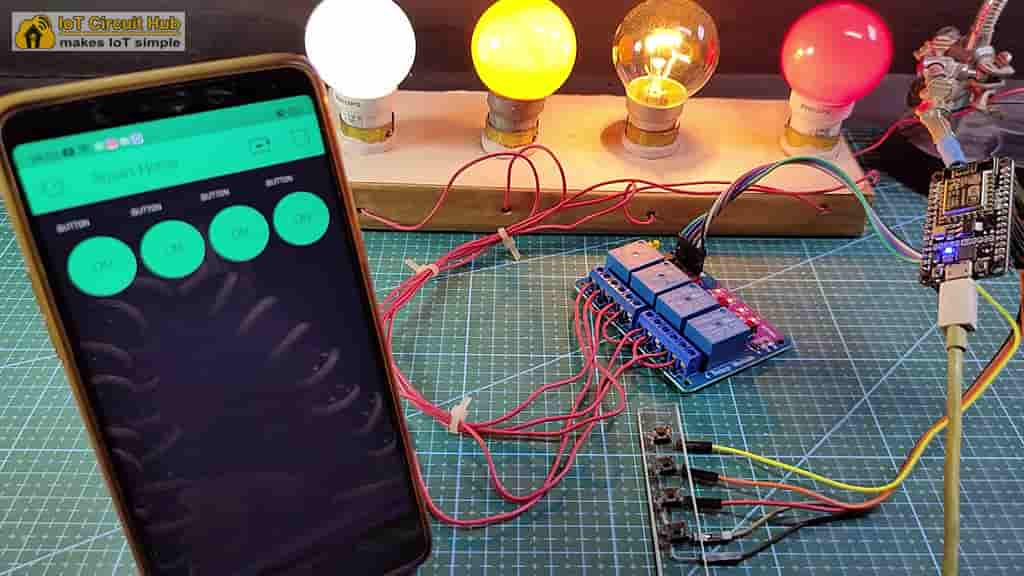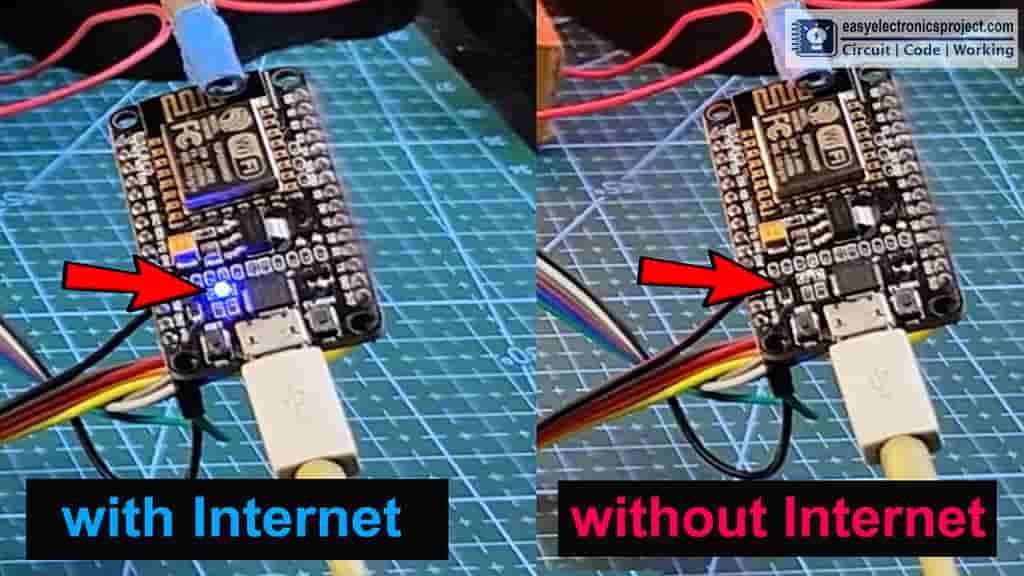In this NodeMCU ESP8266 project, I have shown how to make a home automation system using NodeMCU and Blynk App. With this IoT project, you can control four home appliances from the smartphone and manual switches. If there is no WiFi available then you can control the relay module from manual push buttons.

With this smart home project, you can also monitor the real-time status of the relay module in the Blynk app. If WiFi is available the ESP8266 will automatically connect with the WiFi.
Table of Contents
Circuit of this Blynk ESP8266 Project

The circuit for this NodeMCU Blynk home automation project is very simple. Here I have used an active low 5V relay module. I have used the INPUT_PULLUP function in the code instead of connecting pull-up resistors with the push buttons.
I have used a old 5V mobile charger to supply the circuit.

Required Components for this NodeMCU Project:

- NodeMCU
- 4-channel Relay Module (5V)
- Push Buttons 4nos
Tutorial video on ESP8266 Blynk Home Automation
In this tutorial video, I have explained how to use NodeMCU to make a simple home automation system. How to configure the Blynk app to control any home appliances through the internet. Also explained the code and how to program ESP8266 with Arduino IDE.
Configure the Blynk App:

1. Download the Blynk App from Google play store or App store.
2. Create a new project in the Blynk app. Enter the project name and choose the device. In this IoT project, I have used NodeMCU, so I have selected NodeMCU.
3. After that Blynk will send an Auth Token to the registered email id. The Auth Token will be required while programming the ESP8266.
Adding widgets in Blynk App

Now to control the 4-channel relay module you have to add 4 button widgets in Blynk app
Steps to add the button in Blynk App:
Open the project in the Blynk App Click on the “+” icon on the top.
select the Button.
Click on that button and select the output pin –> V1 & Mode –> Switch
**Here I have used an active low Relay module, so to turn ON the relay we have to send “0” and “1” to turn OFF the relay.
In a similar way create switches with V2, V3, V4 pins to control the second, third & fourth relays
Please refer the tutorial video for configuring the Blynk App
Program NodeMCU with Arduino IDE

For this IoT based home automation project, I have used the Arduino IDE to program NodeMCU.
First update the Preferences –> Aditional boards Manager URLs: https://dl.espressif.com/dl/package_esp32_index.json, http://arduino.esp8266.com/stable/package_esp8266com_index.json
Then install the ESP8266 board from the Board manager or Click Here to download ESP8266 Board.
After that install the Blynk library. Click Here to download the Blynk library.
Code for Blynk Home Automation Project
//#define BLYNK_PRINT Serial
#include <BlynkSimpleEsp8266.h>
// define the GPIO connected with Relays and switches
#define RelayPin1 5 //D1
#define RelayPin2 4 //D2
#define RelayPin3 14 //D5
#define RelayPin4 12 //D6
#define SwitchPin1 10 //SD3
#define SwitchPin2 0 //D3
#define SwitchPin3 13 //D7
#define SwitchPin4 3 //RX
#define wifiLed 16 //D0
#define VPIN_BUTTON_1 V1
#define VPIN_BUTTON_2 V2
#define VPIN_BUTTON_3 V3
#define VPIN_BUTTON_4 V4
int toggleState_1 = 1; //Define integer to remember the toggle state for relay 1
int toggleState_2 = 1; //Define integer to remember the toggle state for relay 2
int toggleState_3 = 1; //Define integer to remember the toggle state for relay 3
int toggleState_4 = 1; //Define integer to remember the toggle state for relay 4
int wifiFlag = 0;
#define AUTH "AUTH TOKEN" // You should get Auth Token in the Blynk App.
#define WIFI_SSID "WIFI NAME" //Enter Wifi Name
#define WIFI_PASS "WIFI PASSWORD" //Enter wifi Password
BlynkTimer timer;
void relayOnOff(int relay){
switch(relay){
case 1:
if(toggleState_1 == 1){
digitalWrite(RelayPin1, LOW); // turn on relay 1
toggleState_1 = 0;
Serial.println("Device1 ON");
}
else{
digitalWrite(RelayPin1, HIGH); // turn off relay 1
toggleState_1 = 1;
Serial.println("Device1 OFF");
}
delay(100);
break;
case 2:
if(toggleState_2 == 1){
digitalWrite(RelayPin2, LOW); // turn on relay 2
toggleState_2 = 0;
Serial.println("Device2 ON");
}
else{
digitalWrite(RelayPin2, HIGH); // turn off relay 2
toggleState_2 = 1;
Serial.println("Device2 OFF");
}
delay(100);
break;
case 3:
if(toggleState_3 == 1){
digitalWrite(RelayPin3, LOW); // turn on relay 3
toggleState_3 = 0;
Serial.println("Device3 ON");
}
else{
digitalWrite(RelayPin3, HIGH); // turn off relay 3
toggleState_3 = 1;
Serial.println("Device3 OFF");
}
delay(100);
break;
case 4:
if(toggleState_4 == 1){
digitalWrite(RelayPin4, LOW); // turn on relay 4
toggleState_4 = 0;
Serial.println("Device4 ON");
}
else{
digitalWrite(RelayPin4, HIGH); // turn off relay 4
toggleState_4 = 1;
Serial.println("Device4 OFF");
}
delay(100);
break;
default : break;
}
}
void with_internet(){
//Manual Switch Control
if (digitalRead(SwitchPin1) == LOW){
delay(200);
relayOnOff(1);
Blynk.virtualWrite(VPIN_BUTTON_1, toggleState_1); // Update Button Widget
}
else if (digitalRead(SwitchPin2) == LOW){
delay(200);
relayOnOff(2);
Blynk.virtualWrite(VPIN_BUTTON_2, toggleState_2); // Update Button Widget
}
else if (digitalRead(SwitchPin3) == LOW){
delay(200);
relayOnOff(3);
Blynk.virtualWrite(VPIN_BUTTON_3, toggleState_3); // Update Button Widget
}
else if (digitalRead(SwitchPin4) == LOW){
delay(200);
relayOnOff(4);
Blynk.virtualWrite(VPIN_BUTTON_4, toggleState_4); // Update Button Widget
}
}
void without_internet(){
//Manual Switch Control
if (digitalRead(SwitchPin1) == LOW){
delay(200);
relayOnOff(1);
}
else if (digitalRead(SwitchPin2) == LOW){
delay(200);
relayOnOff(2);
}
else if (digitalRead(SwitchPin3) == LOW){
delay(200);
relayOnOff(3);
}
else if (digitalRead(SwitchPin4) == LOW){
delay(200);
relayOnOff(4);
}
}
BLYNK_CONNECTED() {
// Request the latest state from the server
Blynk.syncVirtual(VPIN_BUTTON_1);
Blynk.syncVirtual(VPIN_BUTTON_2);
Blynk.syncVirtual(VPIN_BUTTON_3);
Blynk.syncVirtual(VPIN_BUTTON_4);
}
// When App button is pushed - switch the state
BLYNK_WRITE(VPIN_BUTTON_1) {
toggleState_1 = param.asInt();
digitalWrite(RelayPin1, toggleState_1);
}
BLYNK_WRITE(VPIN_BUTTON_2) {
toggleState_2 = param.asInt();
digitalWrite(RelayPin2, toggleState_2);
}
BLYNK_WRITE(VPIN_BUTTON_3) {
toggleState_3 = param.asInt();
digitalWrite(RelayPin3, toggleState_3);
}
BLYNK_WRITE(VPIN_BUTTON_4) {
toggleState_4 = param.asInt();
digitalWrite(RelayPin4, toggleState_4);
}
void checkBlynkStatus() { // called every 3 seconds by SimpleTimer
bool isconnected = Blynk.connected();
if (isconnected == false) {
wifiFlag = 1;
digitalWrite(wifiLed, HIGH); //Turn off WiFi LED
}
if (isconnected == true) {
wifiFlag = 0;
digitalWrite(wifiLed, LOW); //Turn on WiFi LED
}
}
void setup()
{
Serial.begin(9600);
pinMode(RelayPin1, OUTPUT);
pinMode(RelayPin2, OUTPUT);
pinMode(RelayPin3, OUTPUT);
pinMode(RelayPin4, OUTPUT);
pinMode(wifiLed, OUTPUT);
pinMode(SwitchPin1, INPUT_PULLUP);
pinMode(SwitchPin2, INPUT_PULLUP);
pinMode(SwitchPin3, INPUT_PULLUP);
pinMode(SwitchPin4, INPUT_PULLUP);
//During Starting all Relays should TURN OFF
digitalWrite(RelayPin1, toggleState_1);
digitalWrite(RelayPin2, toggleState_2);
digitalWrite(RelayPin3, toggleState_3);
digitalWrite(RelayPin4, toggleState_4);
WiFi.begin(WIFI_SSID, WIFI_PASS);
timer.setInterval(3000L, checkBlynkStatus); // check if Blynk server is connected every 3 seconds
Blynk.config(AUTH);
}
void loop()
{
if (WiFi.status() != WL_CONNECTED)
{
Serial.println("WiFi Not Connected");
}
else
{
Serial.println("WiFi Connected");
Blynk.run();
}
timer.run(); // Initiates SimpleTimer
if (wifiFlag == 0)
with_internet();
else
without_internet();
}Enter the following WiFi credential and Authentication token in the code:
- WiFi Name at “WiFi Name”
- WiFi Password at “WiFi Password”
- Auth Token sent by Blynk at “AUTH TOKEN“
Then Goto Tools and select the board as “NodeMCU 1.0 ESP-12E” and the proper PORT in Arduino IDE.
Then click on the upload button to program the NodeMCU board.

After uploading the code, the blue LED connected with pin D0 should turn on as shown in the picture.
If the wifi is not available, the blue LED will turn off. Then you can control the relay module with push buttons.
If the internet comes back the NodeMCU will automatically connect with the WiFi and the blue LED will turn on.
Connect Home Appliances with Relay

Now, connect 4 home appliances with relay module as per the above circuit.
Please take proper safety precaution while working with high voltage.
NodeMCU ESP8266 Home Automation System is now ready.

Now, you can easily control the home appliances from the smartphone using Blynk App. And you can also monitor the real-time status of switches in the Blynk app.

You can also control the home appliances manually from the push buttons. even if there is no internet sill you can use the push buttons to control the home appliances.
I hope you like this Smart house IoT projects idea with the ESP8266 and Blynk app.
Click Here for more such ESP8266 projects.
Please do share your feedback on this IoT project. Thank you for your time.




